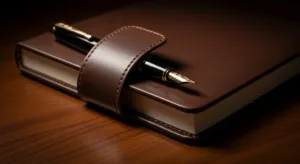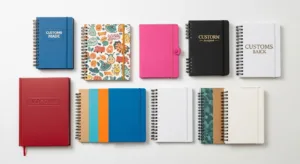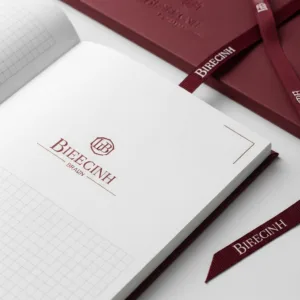Struggling to select the ideal notebook binding options for your corporate projects? This guide demystifies choices from economical saddle stitch to premium case binding, helping you expertly balance cost, quality, and brand impact. Get ready to make informed decisions that elevate your custom notebooks and achieve your business goals.
Selecting the best notebook binding option involves matching the binding method—such as saddle stitch, perfect, sewn, case, or spiral—to your project’s specific page count, durability requirements, lay-flat needs, budget, and desired professional appearance for maximum brand impact and user satisfaction.
Want to dive deeper into the specific pros and cons of each binding type, see detailed cost considerations, understand how to match bindings to precise corporate scenarios? Our full, comprehensive guide below has all the details you need to become a savvy decision-maker.
What is Notebook Binding?
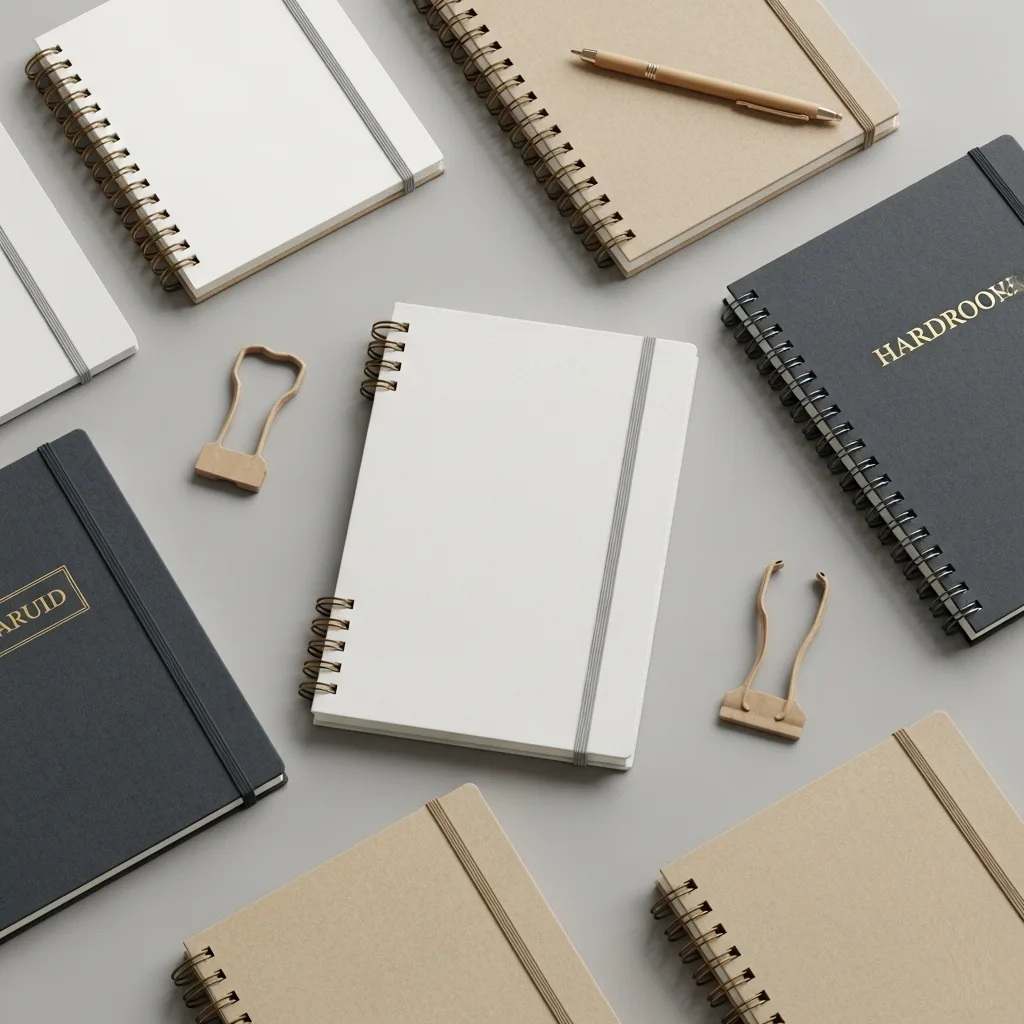
Simply put, notebook binding is the method used to secure a notebook’s pages and cover together, forming a cohesive, functional product.
Why Binding Choice is Critical for Your Success
For your business, the binding is a strategic element. It directly influences:
- Perceived Value & ROI: Quality binding signals care, enhancing your investment’s return, as the tangible quality of marketing materials significantly shapes brand perception and perceived value.
- Brand Image: It’s a tangible brand reflection. As stationery expert Jerome Wu of Interwell Stationery notes:
The choice of notebook binding…fundamentally impacts the notebook’s durability, usability, and the perceived value of the brand it represents.
- User Experience: It dictates ease of use, like whether the notebook lays flat.
- Durability: Good binding ensures your message lasts longer.
A Closer Look: Key Notebook Binding Methods for Corporate Needs
Understanding these common notebook binding options will empower your selection.
Saddle Stitching: The Economical Workhorse for Slim Profiles
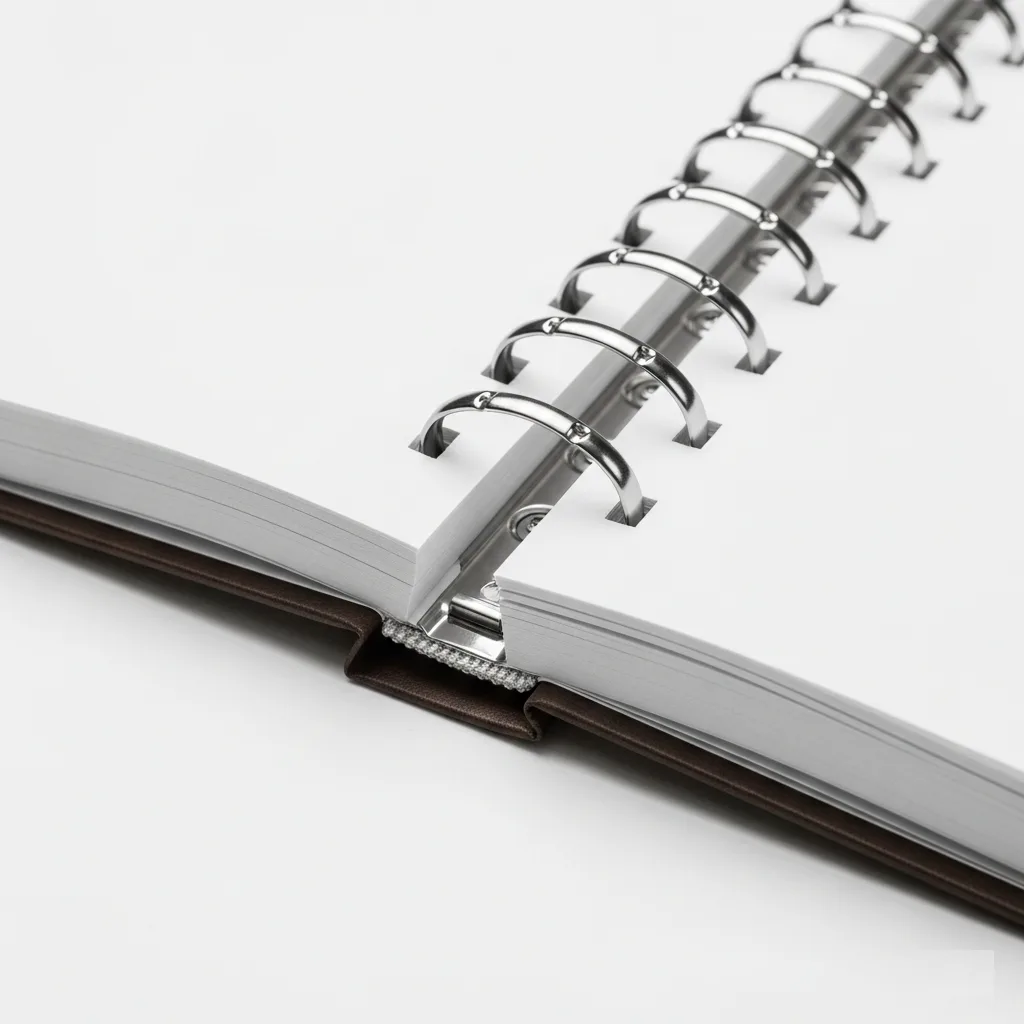
Saddle stitching is a go-to for simple, slim publications due to its speed and cost-effectiveness, making it an excellent notebook binding option for certain projects.
Process & Visuals: Printed sheets are folded in half and nested one inside the other. Wire staples (usually two, but sometimes more for larger formats) are then driven through the folded crease from the outside and clinched in the centerfold. This creates a lightweight notebook, similar in construction to a magazine, that typically lays quite flat when opened.
Key Advantages:
- Lay-Flat: Excellent, especially for lower page counts.
- Turnaround: Very fast, typically 3-5 business days.
Key Considerations:
- Page Count: Best for low page counts, generally up to ~64 pages using standard paper weights. (Note: Some sources mention up to 200 pages for very thin newsprint, but this is less common for corporate notebooks). Exceeding this with thicker paper can cause bulging or “page creep.”
- Spine: Not flat or printable, so no branding visibility on a shelf.
- Limitations: Not as durable as other methods for heavy or long-term use.
- Illustrative Cost (for 1000 units, A5, ~32-64pp, standard specs, ex-China): $0.50 – $1.20 per unit.
- Durability Level: Basic.
- Branding & Customization: Primarily focused on the printed cover (front, back, inside front, inside back).
- Ideal Corporate Uses: Thin event programs, informational pamphlets, company newsletters, product inserts, marketing mailers, or very budget-conscious, high-volume promotional giveaways where a slim profile and quick delivery are essential.
- Example Scenario: A 20-page seminar program and agenda, distributed to all event attendees.
Perfect Binding: Professional Softcover Sophistication
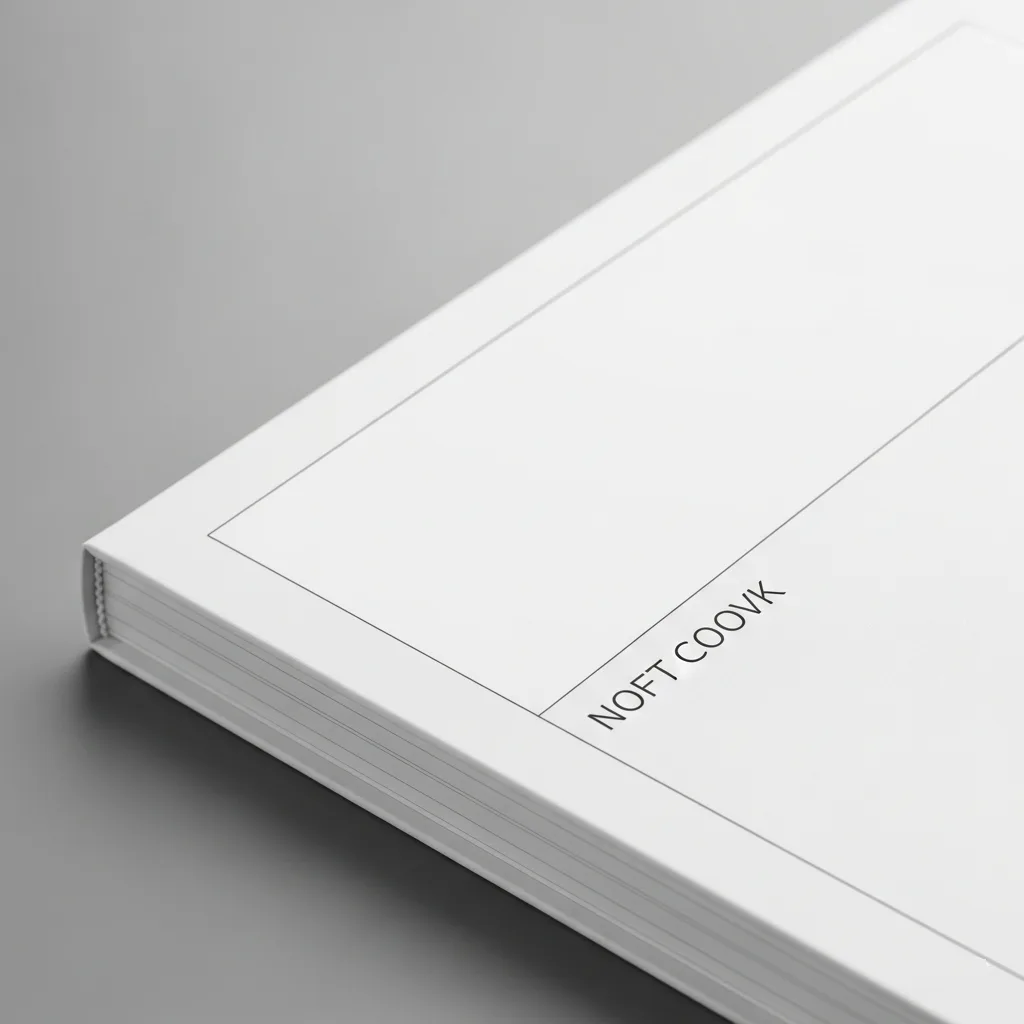
Perfect binding is a highly popular choice for achieving a clean, professional, book-like finish, widely used for softcover corporate notebooks, annual reports, magazines, and product catalogs.
Process & Visuals: The edges of stacked printed pages are roughened, and then a strong, flexible adhesive is applied along the spine edge. A wraparound cardstock cover (often 260-300gsm) is then attached to this glued spine. Finally, the three open sides of the book are trimmed to create perfectly smooth, “perfect” edges and a neat, square printable spine.
Key Advantages:
- Appearance: Highly professional, sleek, and modern.
- Branding: The flat, printable spine is excellent for displaying titles, logos, and volume information, enhancing shelf presence and brand visibility.
- Turnaround: Efficient for a quality finish, typically ~5-7 business days.
Key Considerations:
- Lay-Flat: Traditional perfect binding using standard EVA glue may not allow the notebook to lay completely flat, which can sometimes be a drawback for intensive writing near the spine. A minimum spine thickness of approximately 1/8 inch (3.2mm) is generally required for proper adhesion.
- Page Count: Very versatile, suitable for projects ranging from ~20 pages up to 800 pages (inner paper often ranges from 80gsm to 170gsm).
Adhesive Choice: EVA vs. PUR for Enhanced Performance
The type of adhesive is crucial in perfect binding:
EVA (Ethylene Vinyl Acetate): This is the standard, more economical hot-melt adhesive. It’s suitable for many general applications.
PUR (Polyurethane Reactive): This is a premium adhesive that is significantly stronger and much more flexible than EVA. PUR-bound notebooks can open much flatter (sometimes nearly flat) and offer superior durability due to PUR’s unique bonding properties, with pages far less likely to come loose.
For corporate items where longevity, a premium feel, and an enhanced user experience are important (like training manuals or high-value client notebooks), PUR offers substantially better long-term value and brand reflection, often justifying a slightly higher initial cost.
- Illustrative Cost (for 1000 units, A5, ~96-128pp, standard specs, ex-China): With EVA glue: $1.50 – $2.80 per unit. With PUR glue: $1.80 – $3.20 per unit.
- Durability Level: Good (with EVA glue) to Excellent (with PUR glue).
- Branding & Customization: Excellent, with the full cover (front, back, and spine) available for printing and various finishes.
- Ideal Corporate Uses: Employee handbooks, company profiles, annual reports, product catalogs, training manuals (PUR highly recommended for better lay-flat), corporate magazines, and sophisticated marketing brochures.
- Example Scenario: A 150-page employee onboarding guide, designed for durability and a professional appearance, bound with PUR adhesive for better usability.
Sewn Binding (Smyth Sewn/Section Sewn): The Hallmark of Durability & Quality
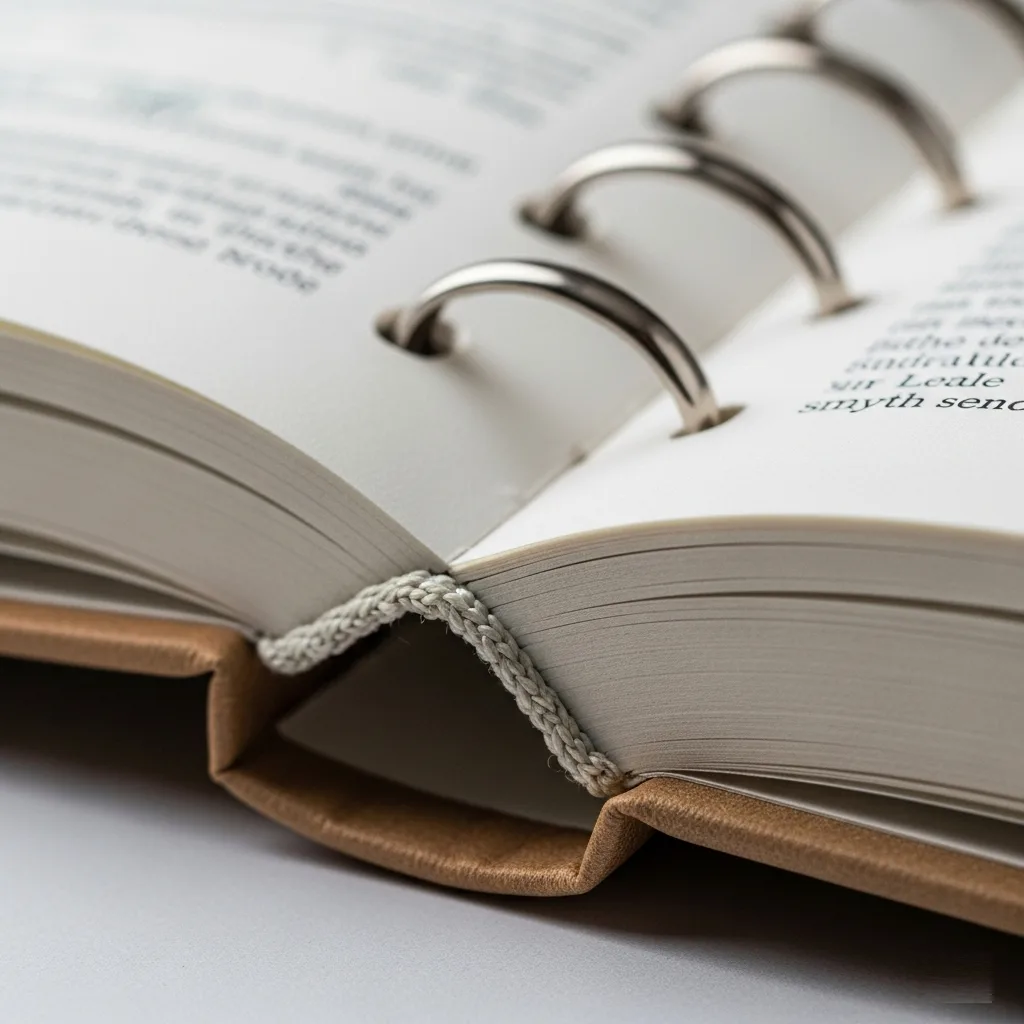
For corporate projects demanding exceptional durability, a premium feel, and excellent lay-flat capability, sewn binding (often referred to as Smyth sewn or section sewn) is a top-tier notebook binding option. It’s the foundation of most high-quality softcover and hardcover books.
Process & Visuals: Pages are printed and folded into “signatures” or sections (e.g., 16 or 32 pages each). Each signature is then individually stitched through its fold with thread. These sewn signatures are compiled, and the spine of this text block is often glued before being attached to a softcover or forming the core of a hardcover book. The visible thread in the centerfold of each section is a clear indicator of this quality method.
Key Advantages:
- Durability: Unparalleled; pages are incredibly secure and will not fall out.
- Lay-Flat: Excellent, allowing the notebook to open flat for a superior writing and reading experience.
- Quality Perception: High-end, signifies craftsmanship and longevity.
- Turnaround: Typically around 10-15 business days due to the more intricate process.
Key Considerations:
- Page Count: Versatile, suitable for notebooks from approximately ~40 pages up to 800+ pages.
- Limitations: One of the more expensive binding methods due to the labor and machinery involved.
- Illustrative Cost (for 1000 units, A5, ~96-128pp, softcover, sewn, standard specs, ex-China): $2.50 – $4.50 per unit.
- Durability Level: Excellent – one of the most robust and long-lasting binding methods.
- Branding & Customization: Excellent, especially when combined with quality cover materials and finishes. The spine (if a softcover or part of a hardcover) is typically printable.
- Ideal Corporate Uses: High-value client gifts, archival notebooks, premium internal journals for executives, reference books intended for frequent use, and any notebook designed to be a lasting keepsake.
- Example Scenario: A corporate anniversary book detailing the company’s history, intended to be a lasting memento for employees and stakeholders.
Case Binding (Hardcover): The Ultimate Statement of Quality and Longevity
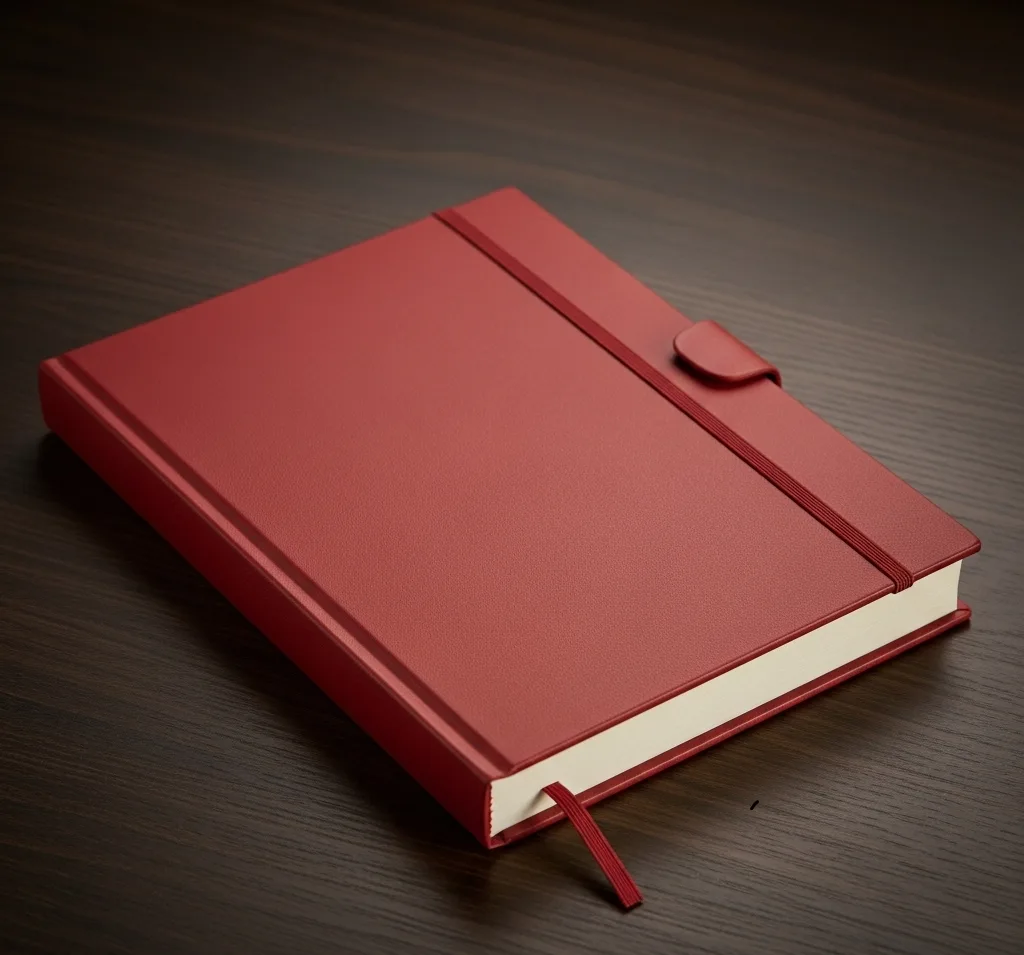
When your business objective is to present a notebook that unequivocally conveys prestige, exceptional quality, and is built to endure for generations, case binding – universally known as hardcover binding – is the premier notebook binding option.
Process & Visuals: This sophisticated method typically involves creating a text block where the pages are Smyth sewn together in sections for maximum strength. This sewn block is then securely attached (often with strong endpapers) to rigid cover boards (frequently ~2.5mm-3mm / 2750 microns thick). These boards are pre-wrapped with a chosen cover material – such as printed paper (often laminated), book cloth, real or imitation leather, or other specialized materials. The result is a substantial, rigid, and highly protective notebook.
Key Advantages:
- Durability: Unmatched protection and longevity, designed to withstand significant wear.
- Appearance: Classic, high-end, and often luxurious.
- Perceived Value: The highest among common binding types.
- Turnaround: Typically around 15-20 business days due to the multiple production steps.
Key Considerations:
- Weight: This is generally the heaviest binding option.
- Lay-Flat: Quality sewn hardcovers are designed to lay flat well, especially after being gently “broken in.”
- Page Count: Well-suited for substantial books, generally from ~50 pages up to 800 pages, and can even accommodate over 1000 pages for larger volumes.
- Illustrative Cost (for 1000 units, A5, ~96-128pp, sewn block, standard printed wrap cover, ex-China): $3.50 – $7.00+ per unit (can increase significantly with premium cover materials like real leather or extensive handwork).
- Durability Level: Superior – the most robust and long-lasting option.
- Branding & Customization: Superb. The rigid covers provide an excellent canvas for diverse printing techniques, foil stamping, embossing/debossing, and a wide choice of luxurious or specialized cover materials. The spine is also fully printable and often features detailed branding.
- Ideal Corporate Uses: Prestigious executive gifts, commemorative editions (like anniversary books or company histories), important reference books, high-value client presentations, and any notebook intended to be a cherished, long-lasting item.
- Example Scenario: A bespoke company yearbook or a special edition notebook celebrating a significant corporate milestone, designed to be a lasting archive and symbol of achievement.
Spiral & Wire-O Binding: Functionality First for Practical Applications
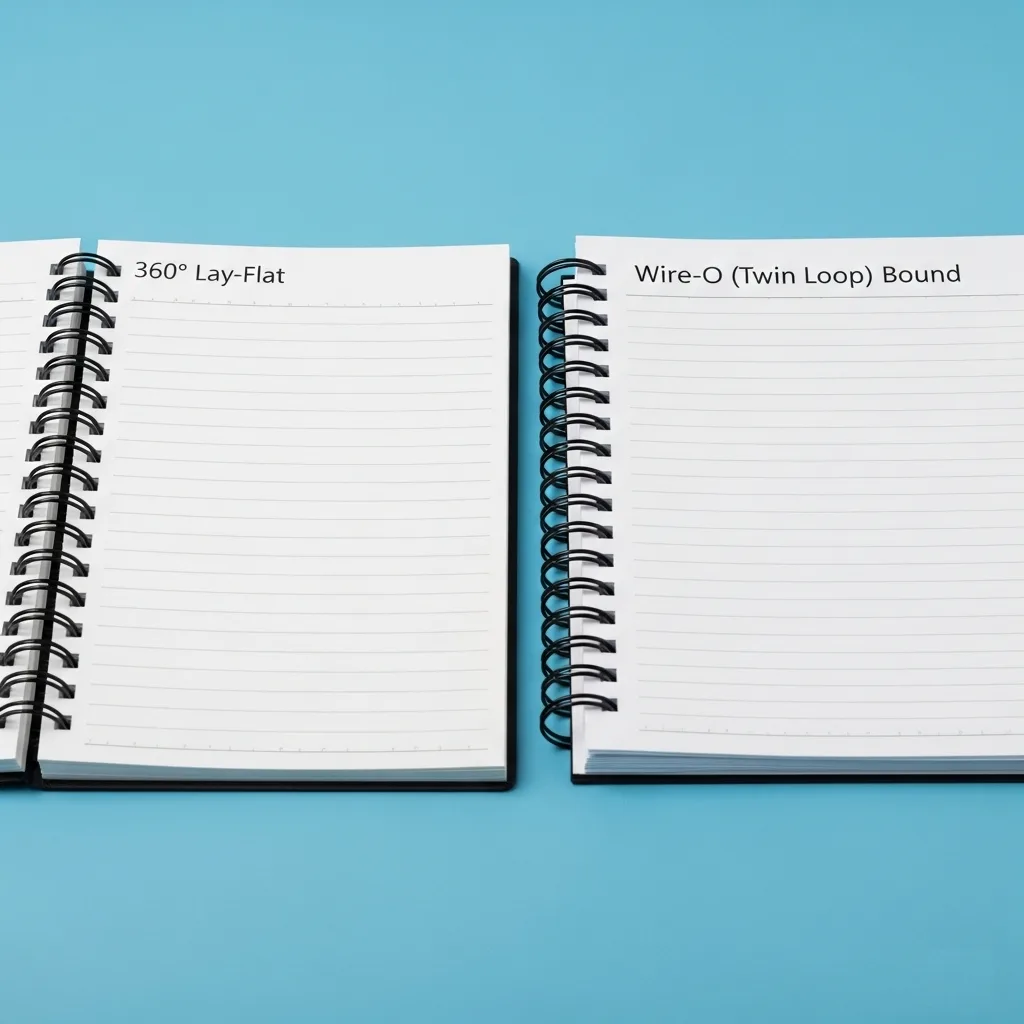
For notebooks that need to be exceptionally user-friendly, especially when it comes to laying completely flat or even folding back on themselves for unhindered writing or referencing, spiral and Wire-O binding are popular and highly functional notebook binding options.
Process & Visuals: Both methods involve punching a series of small holes along the spine edge of the stacked pages and covers. Then, a continuous coil (for spiral binding) or a series of double-loop wires (for Wire-O) is threaded through these holes to secure the notebook. This allows the notebook to open a full 360 degrees.
Distinguishing Spiral (Coil) from Wire-O (Twin Loop)
Spiral (Coil) Binding: Uses a single, continuous plastic or metal helical coil (like a spring) that is spun through the holes. Plastic coils are available in many colors and are quite durable and flexible.
Wire-O (Twin Loop or Double Loop) Binding: Employs a series of C-shaped double-wire loops that are clamped shut to form a circular spine. This often gives a more refined or professional appearance compared to plastic spiral coils and allows pages to align more perfectly when turned.
Key Advantages:
- Lay-Flat: Excellent; can be folded back 360 degrees, making them ideal for writing or referencing while using minimal desk space. Stationery reviewer Brad Dowdy of The Pen Addict notes:
“A binding that allows a notebook to lay flat, like…a spiral, drastically improves usability…”
- Turnaround (Wire-O): Efficient, often around 5-10 business days.
Key Considerations:
- Spine: Neither method offers a flat, printable spine for easy shelf identification.
- Limitations: While generally durable, the coils or wires can sometimes bend or get snagged if the notebook is roughly handled, though using high-quality components minimizes this.
- Page Count: Spiral binding can often accommodate up to around 400 pages (or a substantial 2-inch thickness); Wire-O is frequently recommended for optimal performance with around ~10 to 200 pages.
- Illustrative Cost (for 1000 units, A5, ~96-128pp, standard specs, ex-China): Plastic Spiral: $1.30 – $2.50 per unit. Metal Wire-O: $1.60 – $3.00 per unit.
- Durability Level: Good to Very Good (metal coils/wires are typically more durable and offer a more premium perception than plastic).
- Branding & Customization: Primarily on the front and back covers. The color of the plastic coil or metal wire can often be chosen to complement brand colors.
- Ideal Corporate Uses: Excellent for training manuals, workbooks, planners, conference notebooks, presentations that need to stay open, and internal documents where ease of use is paramount.
- Example Scenario: Wire-O bound training manuals for a new software rollout, allowing users to lay them flat beside a computer for easy reference during exercises.
Singer Sewn Binding: Artisan Appeal with Functional Flat Lay
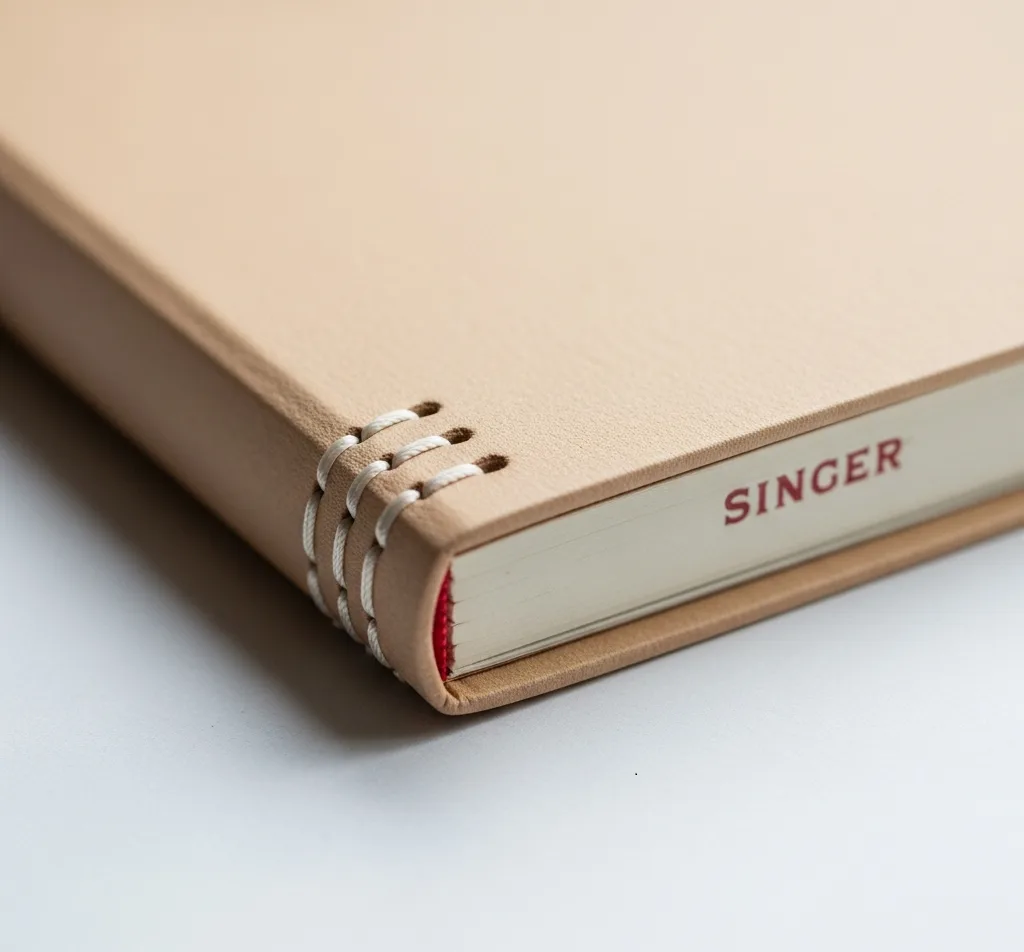
For businesses looking to imbue their custom notebooks with a unique, handcrafted feel combined with excellent lay-flat functionality, Singer sewn binding is a distinctive and increasingly sought-after notebook binding option.
Process & Visuals: This method involves stitching folded pages (often formed into one or a few ‘signatures’) directly through the spine with a single, continuous thread, typically on an industrial Singer sewing machine. The stitching (which can feature up to 40 stitches depending on size and design) is visibly exposed along the exterior of the spine, becoming an integral part of the notebook’s aesthetic.
Key Advantages:
- Lay-Flat: Opens completely flat from the first page to the last, ideal for writing or sketching across a full spread.
- Aesthetic: Minimalist, artisanal, and unique, offering a sophisticated, handcrafted appearance.
- Customization: The thread color can often be customized to match or contrast with the cover design, providing a unique branding touch.
Key Considerations:
- Page Count: Generally best suited for notebooks with a lower to moderate page count, often comparable to or slightly more than saddle stitch, typically up to around ~64 pages.
- Spine: Does not have a flat, printable spine; the thread is the visual feature.
- Turnaround: Varies; while the sewing can be quick, custom setups or smaller runs might take longer than basic saddle stitch but usually less than complex bindings.
- Illustrative Cost (for 1000 units, A5, ~32-64pp, standard specs, ex-China): $1.00 – $2.50 per unit.
- Durability Level: Good. The direct stitching is quite secure for the intended page counts.
- Branding & Customization: Primarily through cover design and the unique ability to choose the thread color for the visible spine stitching.
- Ideal Corporate Uses: Perfect for boutique brand promotions, creative portfolios, special internal communications where a unique touch is desired, high-quality marketing booklets, or as an elegant alternative to saddle stitching for thin, premium-feel notebooks.
- Example Scenario: A design agency creating a lookbook of their work, choosing Singer sewn binding with a contrasting, on-brand thread color for its sophisticated, handcrafted aesthetic and excellent lay-flat presentation.
For more detailed guidance, refer to our article on Choosing the Perfect Cover for Your Custom Notebooks.
Making the Smart Choice
Understanding the diverse range of notebook binding options is your crucial first step. Now, the pivotal question for your business is: which specific method will best achieve your project’s objectives, enhance your brand image, and fit within your financial plan?
This section is dedicated to helping you navigate that decision by providing a clear comparative overview and then matching binding types to distinct corporate needs and strategic goals.
Quick Feature Comparison at a Glance
Notebook Binding Options: A Comparative Overview:
| Binding Method | Lay-Flat Quality | Durability | Typical Page Count | Printable Spine | Key Characteristics | Ideal For |
|---|---|---|---|---|---|---|
| Saddle Stitch | Excellent | Basic | Low (~8-64 pp) | No | Lightweight, simple, magazine-like | Thin programs, pamphlets, newsletters, budget giveaways |
| Perfect Binding | Fair (EVA) to Good/Very Good (PUR) | Good (EVA) to Excellent (PUR) | Medium-High (~20-800 pp) | Yes | Sleek, professional softcover, square spine | Handbooks, reports, catalogs, manuals (PUR for better lay-flat) |
| Sewn Binding(Smyth Sewn Softcover) | Excellent | Excellent | Medium-High (~40-800+ pp) | Yes | Premium quality, highly durable, flexible spine | High-value gifts, archival notebooks, premium journals |
| Case Binding(Hardcover) | Good to Very Good<br>(once broken in) | Superior | High (~50-1000+ pp) | Yes | Luxurious, highly protective, ultimate perceived value | Executive gifts, commemorative books, key reference volumes |
| Spiral & Wire-O | Excellent (360° fold-back) | Good to Very Good | Medium-High (~10-400 pp) | No | Highly functional, easy page-turning, lays completely flat | Training manuals, workbooks, planners, conference notes |
| Singer Sewn | Excellent | Good | Low-Medium (up to ~64 pp) | No (thread is design) | Artisan, minimalist, unique visible stitching | Boutique promotions, portfolios, creative booklets |
To help you quickly weigh your options, here’s a simplified comparison of the main binding methods we’ve discussed, now incorporating illustrative cost ranges per unit.
Saddle Stitch:
- Lay-Flat: Excellent
- Durability: Basic
- Illustrative Cost (1000 units, A5, ~32-64pp): $0.50 – $1.20 per unit
- Key Trait: Lightweight, simple, magazine-like
- Page Capacity: Low (~8-64 pages)
- Spine Print: No
Perfect Binding (EVA/PUR):
- Lay-Flat: Fair (EVA) to Good/Very Good (PUR)
- Durability: Good (EVA) to Excellent (PUR)
- Illustrative Cost (1000 units, A5, ~96-128pp): With EVA glue: $1.50 – $2.80 per unit With PUR glue: $1.80 – $3.20 per unit
- Key Trait: Sleek, professional, book-like square spine
- Page Capacity: Medium to High (~20-800 pages)
- Spine Print: Yes
Sewn Binding (Smyth/Section Sewn, for Softcover):
- Lay-Flat: Excellent
- Durability: Excellent
- Illustrative Cost (1000 units, A5, ~96-128pp, softcover): $2.50 – $4.50 per unit
- Key Trait: Premium quality, highly durable, flexible spine
- Page Capacity: Medium to High (~40-800+ pages)
- Spine Print: Yes
Case Binding (Hardcover, typically with sewn block):
- Lay-Flat: Good to Very Good (once “broken in”)
- Durability: Superior
- Illustrative Cost (1000 units, A5, ~96-128pp): $3.50 – $7.00+ per unit
- Key Trait: Luxurious, highly protective, ultimate perceived value
- Page Capacity: High (~50-1000+ pages)
- Spine Print: Yes
Spiral & Wire-O Binding:
- Lay-Flat: Excellent (full 360° fold-back)
- Durability: Good to Very Good (metal options are more robust)
- Illustrative Cost (1000 units, A5, ~96-128pp): Plastic Spiral: $1.30 – $2.50 per unit Metal Wire-O: $1.60 – $3.00 per unit
- Key Trait: Highly functional, easy page-turning
- Page Capacity: Medium to High (~10-400 pages)
- Spine Print: No
Singer Sewn Binding:
- Lay-Flat: Excellent
- Durability: Good
- Illustrative Cost (1000 units, A5, ~32-64pp): $1.00 – $2.50 per unit
- Key Trait: Artisan, minimalist, unique visible stitching
- Page Capacity: Low to Medium (typically up to ~64 pages)
- Spine Print: No (thread is the design focus)
This quick comparison should give you a clearer starting point for narrowing down the notebook binding options that might be most suitable for your project. Next, we’ll look at how to match these to specific business needs and goals.
Sourcing Excellence: Bulk Customization & Manufacturer Partnerships (Focus: China)
Production is next. For quality custom notebooks in bulk at competitive prices, China is a leading hub. If you’re considering this route, Book Printing in China offers a comprehensive overview.
Why China for Custom Notebook Production?
Advantages beyond cost for notebook binding options:
- Integrated Supply Chains: Quick access to diverse materials & advanced machinery (which Mainland Printing leverages).
- Tech Breadth: Expertise from automated lines to skilled craft binding.
- Trend Adaptability: Quick adoption of new materials (FSC) & finishes.
- Supplier Selection: Look for experience, in-house binding, transparent QC.
Clear Specifications & Quality Assurance for Success
Communication is vital:
- Provide Detailed Specs: Specify binding (‘PUR Perfect Bound’), paper (‘100gsm uncoated’), cover, print, finishes.
- The Power of Samples: Always request pre-production samples to check binding integrity, print, and finish.
- Key Binding QC Checks: Glue consistency, page security, spine formation, trim, cover adhesion.
“China+1” Sourcing for Notebooks: A Note
For complex custom notebooks needing specialized materials, diverse notebook binding options, and quality, China’s ecosystem remains highly advantageous. If considering alternatives, vet their material sources and in-house binding expertise.
Advanced Insights & Future Trends in Notebook Binding
The world of notebook binding options is dynamic.
The Evolution of Lay-Flat Binding
Beyond spiral/sewn, look for advanced lay-flat perfect binding using flexible PUR and special spine prep, balancing sleekness with practicality.
Sustainability in Notebook Production
A growing priority:
- Eco-Materials: Demand for FSC-certified/recycled paper and sustainable covers. To dive deeper into selecting the ideal paper and layout for your project, see our Custom Notebook Inner Pages Guide.
- Greener Processes: Vegetable/water-based inks, eco-friendly glues.
- Binding for Recyclability: Some bindings (Singer sewn, simpler spiral) are easier to recycle.
Personalization at Scale with Digital Print & Versatile Binding
Digital printing enables unique content per notebook (names, custom agendas), professionally bound with PUR perfect or Wire-O, for impactful corporate items even in smaller batches.
Conclusion: Choosing Binding to Amplify Your Brand & Goals
Selecting the right notebook binding option is strategic, impacting budget, brand, and user experience. Consider these key factors:
- Purpose: Brand promo, internal tool, event?
- Audience: Who will use it?
- Budget: Value considered?
- Durability Needs: How long must it last?
- Lay-Flat Needs: Critical for writing?
- Brand Image: Message to convey?
- Quantity: How many?
Frequently Asked Questions (FAQs)
Quick answers to common business queries:
- Q1: Most durable binding for daily corporate use?
A1: Case Binding (hardcover) with Smyth sewn sections is superior. For durable softcover, Sewn Binding or Perfect Binding with PUR adhesive. - Q2: Can I get a quality lay-flat notebook that isn’t spiral-bound?
A2: Yes! Sewn Binding, Singer Sewn, and innovative Perfect Binding using flexible PUR glue offer excellent lay-flat performance. - Q3: How much does binding impact overall cost for bulk orders?
A3: Binding is primary. Generally: Saddle stitch (most economical) < Spiral/Wire-O & Perfect Binding (EVA < PUR) < Sewn Binding < Case Binding (most premium). Materials, pages, print, and finishes also significantly affect price. Always get a detailed quote.


